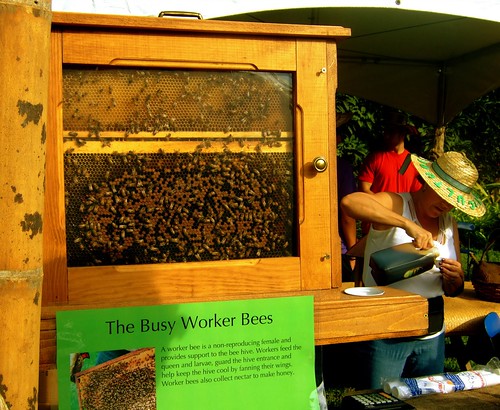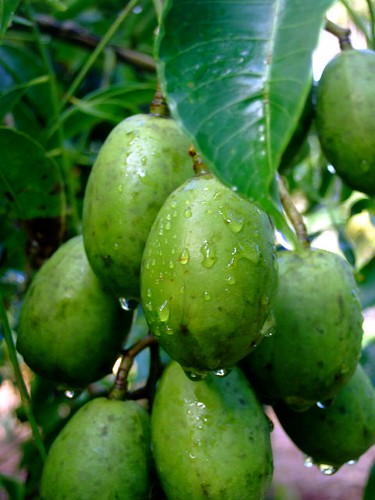 Fruit smoothies, jams, chutneys, honeys and seasonal fruits sold -- all home grown -- at Fairchild Saturdays and Sundays, open during the "season," typically December through May when the art work is on exhibit.
Fruit smoothies, jams, chutneys, honeys and seasonal fruits sold -- all home grown -- at Fairchild Saturdays and Sundays, open during the "season," typically December through May when the art work is on exhibit.I can't believe it, but I've been volunteering for just over seven months already! Here's a recap of my feelings about the experience and what I've learned:
The winter season gets busy at Fairchild, what with the
art exhibits and all. Not rock-concert crazy busy, mind you -- it's not crowded or uncomfortable -- but as with everything in South Florida around this time, more people are expected to show up.
Williams Grove sets up a smoothie stand during "season" weekends and so I've been asked to help. I actually haven't made many smoothies, but I've helped the guys close shop and have done a little horticultural stuff on the side. My buddies have been: Jon-Mario, whom you all already know as the fruit program manager; Ruben, who works at Williams Grove; and JC, a high school student volunteer who mans the smoothie bar like nobody's business.
But mainly, and quite unexpectedly, I have spent time talking to visitors about tropical fruit,
the pavilion and why it's so special, the genetic program as well as the overall garden, its history and architecture. All of the horticultural work I've done, as well as the classes I've taken, have proven invaluable not only in helping me understand and appreciate the garden, but also in explaining it to others. The get-your-hands-dirty work has been great and the classes, equally so -- chock full of information but nothing too heavy.
Over time, the same passion that drew me to the garden in the first place has made it easy for me to talk about it to any random visitor who is willing to listen. Maybe I've also been inspired a little by
Dr. Paul George, who is such a great raconteur about the thing he loves so -- the city of Miami. It's no surprise that my interest in Miami's history coincides with volunteering at Fairchild.
Anyway, it has also been wonderful to meet people from all over the world. That's what I've come across with when I've been there on the weekends this season -- tropical plants and international folk.
 Mr. Stinky isn't part of the fruit program, but these ladies asked me to take them to see the notorious smelly plant. Currently (as you see it above), it's not blooming.
Mr. Stinky isn't part of the fruit program, but these ladies asked me to take them to see the notorious smelly plant. Currently (as you see it above), it's not blooming.One day, I took three women (two locals and one tourist) over to the conservatory to see
Mr. Stinky (
Amorphophallus titanum)
, during which time I answered questions about Fairchild's history and architecture. I was surprised how I just kept blabbing about it, but there you go. They asked me: "Aw come one, why don't you just spend the rest of the day walking around the garden with us?" But of course, volunteer duties called. I felt honored and for this I am thankful.
Another day, I -- along with Ruben from Williams Grove -- inspired a couple to buy a mango tree to plant in their home. The mom of two thanked us for encouraging her not to be afraid to try to grow a mango tree.
Yet another day, I walked a few people through the pavilion, explaining each tree and plant grown there.
Last weekend, I spent about half an hour with some kids, explaining what was inside and outside the pavilion. They were really curious about the fruit trees. It was very rewarding to talk the children; I guess that's because I feel like a kid too, filled with wonder, when I'm working with these amazing plants. I don't have kids or get to spend any time with any, but I do enjoy their company. These kids were really curious and I was amazed at their intelligent questions.
I guess my old role as teacher somehow came out. I never thought I would be attracted to an educational role, because I love horticultural work so much for its solitary and meditative nature -- but then again, there you go ... you just never know when one experience will transform you.
After volunteering here long enough, your knowledge of the garden becomes second nature, yet obviously there is always more to learn, and that's what makes it so rewarding. I can't imagine ever being bored here. It's just one of the many wonderful aspects of being part of this community dedicated to tropical plant conservation.
Think about it -- this is a living museum of plants you take care of every time you show up, you are tending to a horticultural legacy left by Fairchild for all of us to enjoy -- so it's no wonder you're going to get excited about sharing your experiences with others.
In fact, a secret pleasure of mine (don't tell anybody!) is to wander a bit around the arboretum even after the garden is closed and the guard is ushering everyone out. It's at this liminal hour when the sun casts a special golden hue on the garden and somewhere, usually, a wedding is taking place. There is love in the air ... and not just of the matrimonial kind. I
love knowing that these trees came from some far-away land, even if I don't know which particular ones; I
love knowing that I can walk about them, smell the flowers and fully sense the incredible, peaceful yet primeval energy they evoke.
But back to the fruit:
At the smoothie stand, Williams Grove sells mango, papaya, banana and pineapple smoothies, or any combination thereof -- for $3 each. They also sell homemade jams, chutneys, local honey and homegrown fruit. Last week, they had black sapote, canistel, tamarind, papaya and starfruit. I highly recommend the mango chutney; it's divine with roasted chicken or pork. (And it's made by dedicated volunteers, so you know it's going to taste great!)
 This picture is from the harvest festival last fall, but it's basically the same thing you'll see this season near the smoothie stand.
This picture is from the harvest festival last fall, but it's basically the same thing you'll see this season near the smoothie stand. Currently, there is a bee stand that demonstrates apiary (beehive) culture. Don't worry -- they're not aggressive and won't come at you and sting. I was worried about them too, but they keep to their hive. Insects are obviously key to pollination, so we have to love these critters and be their friends.
Tip: if you happen to come to Fairchild and do visit the pavilion, keep in mind there is a great video that loops during visiting hours, so you can hear curators Richard Campbell and Noris Ledesma talk about the program. Make sure you stop and listen. And if I happen to be roaming about, feel free to yap with me about the plants!
 The humble origins of chocolate. This fruit was picked from Fairchild's rainforest during my basic botany class last June. It's the cocoa bean that becomes the tasty stuff we love so much.
The humble origins of chocolate. This fruit was picked from Fairchild's rainforest during my basic botany class last June. It's the cocoa bean that becomes the tasty stuff we love so much. Don't forget about the
Third Annual Chocolate Festival coming up January 24-25. I've actually never been, so I'm looking forward to it. I'll be volunteering that weekend and am in the process of learning more about the world's most favorite tropical plant -- theobroma cacao. (Well, I'm assuming it's the world's most favorite, since chocolate is practically universal.) We have two of them in the pavilion and one of them in the rainforest. But there are supposed to be many chocolate-related exhibits and vendors in the main lawn. Hope to see you there!



















